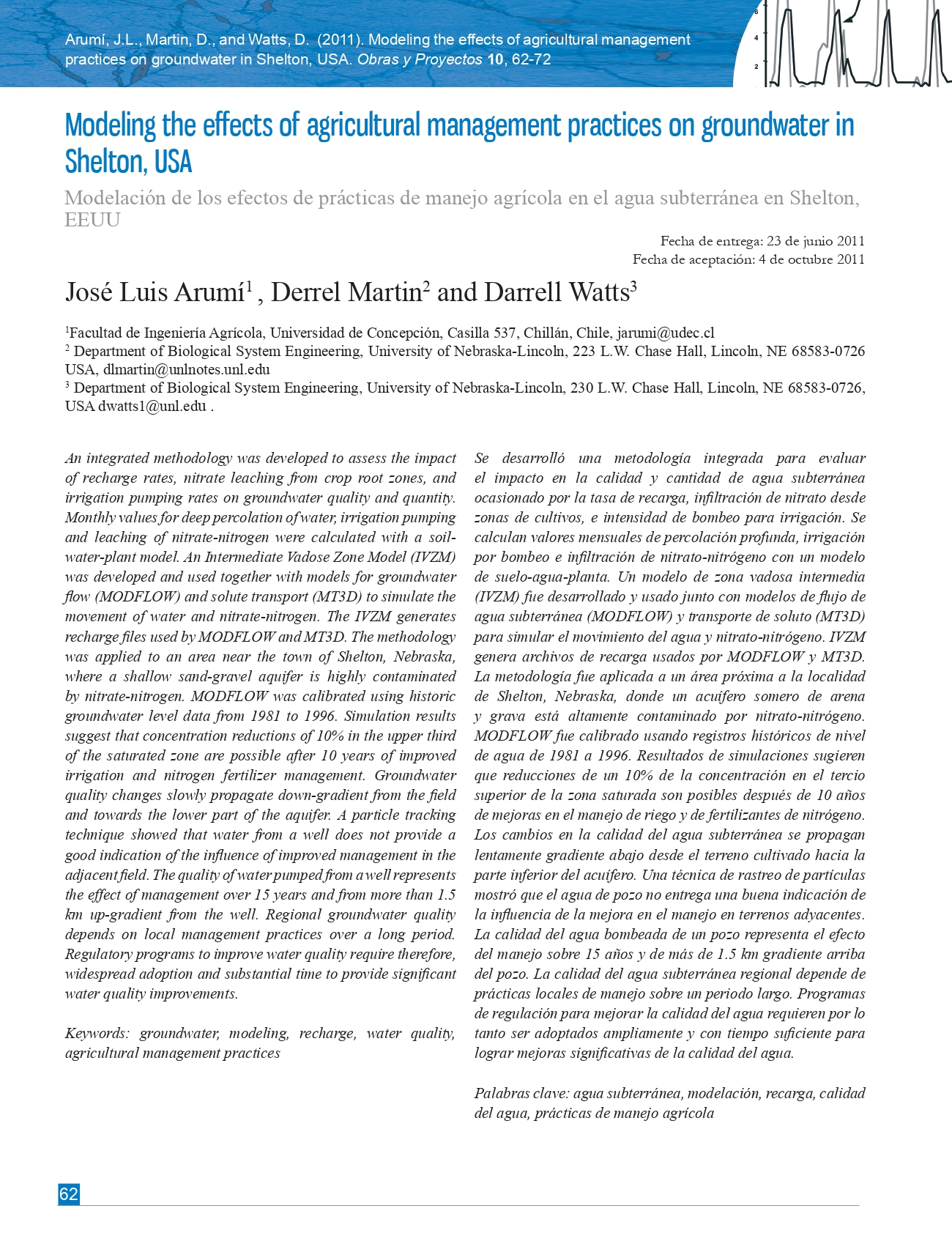Modeling the effects of agricultural management practices on groundwater in Shelton, USA
DOI:
https://doi.org/10.4067/S0718-28132011000200006Keywords:
groundwater, modeling, recharge, water quality, agricultural management practicesAbstract
An integrated methodology was developed to assess the impact of recharge rates, nitrate leaching from crop root zones, and irrigation pumping rates on groundwater quality and quantity. Monthly values for deep percolation of water, irrigation pumping and leaching of nitrate-nitrogen were calculated with a soil-water-plant model. An Intermediate Vadose Zone Model (IVZM) was developed and used together with models for groundwater flow (MODFLOW) and solute transport (MT3D) to simulate the movement of water and nitrate-nitrogen. The IVZM generates recharge files used by MODFLOW andJMT3D. The methodology was applied to an area near the town of Shelton, Nebraska, where a shallow sand-gravel aquifer is highly contaminated by nitrate-nitrogen. MODFLOW was calibrated using historic groundwater level data from 1981 to 1996. Simulation results suggest that concentration reductions of 10% in the upper third of the saturated zone are possible after 10 years of improved irrigation and nitrogen fertilizer management. Groundwater quality changes slowly propagate down-gradient from the field and towards the lower part of the aquifer. A particle tracking technique showed that water from a well does not provide a good indication of the influence of improved management in the adjacentfield. The quality ofwater pumpedfrom a well represents the effect of management over 15 years and from more than 1.5 km up-gradient from the well. Regional groundwater quality depends on local management practices over a long period. Regulatory programs to improve water quality require therefore, widespread adoption and substantial time to provide significant water quality improvements.
References
Arumi, J.L. (2000). Modeling the effects of agricultural management practices on groundwater quality and quantity. PhD thesis, University of Nebraska, Lincoln.
Bredeweg, S.M. (1994). Calibration of EPIC for simulating best management practices for irrigation and nitrogen. MSc thesis, University of Nebraska, Lincoln.
Canter, L. W. (1997). Nitrates in groundwater. CRC Press, Inc. Boca Raton, Florida. https://doi.org/10.1201/9780203745793
CPNRD (1996). Groundwater quality management program. Grand Island, Nebraska.
Diffendal R.F. and Smith, F.A. (1996). Geology beneath the primary Management Systems Evaluation Area (MSEA) site southwest of Shelton, Buffalo County, Nebraska. USGS Water-Supply Paper # 1358, Washington DC.
Gusman, A. J., and Mariño, M. A. (1999). Analytical modeling of nitrogen dynamics in soil and ground water. Journal of Irrigation and Drainage Engineering 125, 330-337.
Kilpatrick, J.M. (1996). Temporal changes in the configuration of the water table in the vicinity of the Management Systems Evaluation Area Site, central Nebraska. USGS Water-Resources Investigation Report 94-4173. Lincoln, Nebraska. https://doi.org/10.3133/wri944173
McGuire, V.L. and Kilpatrick, J.M. (1998). Hydrogeology in the vicinity of the Nebraska management systems evaluation area site, central Nebraska. USGS, Denver, CO. https://doi.org/10.3133/wri974266
Oyarzún, R., Arumí, J., Salgado, L. and Mariño, M. (2007). Sensitivity analysis and field testing of the RISK-N model in the Central Valley of Chile. Agricultural Water Management 87, Issue 3, 251-260. https://doi.org/10.1016/j.agwat.2006.07.008
Peckenpaugh, J.M. and Dugan, J.T. (1983). Hydrogeology of parts of the Central Platte and Lower Loup Natural Resources Districts. Nebraska. U. S. Geological Survey Water-Resources Investigation. Report 83-4219. https://doi.org/10.3133/wri834219
Rawls, W.J., Ahuja, L.R. and Brakensiek, D.L. (1992). Estimating soil hydraulic properties from soils data. Proceedings of the International Workshop on Indirect Methods for Estimating the Hydraulic Properties of Unsaturated Soils. van Genuchten, Liej and Lund, editors. University of California, Riverside, 329-340
Sharpley, A.N. and Williams, J.R. (eds.) (1990). EPIC-Erosion/ Productivity Impact Calculator. 1. Model Documentation. USDA, Tech. Bull. No. 1768.
Snyder, D.T., Wilkinson, J.M. and Orzol, L.L. (1999). Use of a ground-water flow model with particle tracking to evaluate ground-water vulnerability, Clark County, Washington. USGS Water Supply paper; 2488. https://doi.org/10.3133/wsp2488
Spalding, R.F., Watts, D.G., Schepers, J.S., Burbach, M.E., Exner, M.E., Poreda, R.J. and Martin, G.E. (2001). Effect of management systems on nitrate leaching in irrigated agriculture. Journal of Environmental Quality 30(4):1184-1194
USDA-SCS (1974). Soil survey of Buffalo County, Nebraska. U.S. Department of Agriculture.
Williams, J. R., Dyke, P. T., Fuchs, W. W., Benson, V. W., Rice, O. W. and Taylor, E. D. (1990). EPIC-Erosion/Productivity Impact Calculator. 2. User Manual. A. N. Sharpley and J. R. Williams (eds.) USDA, Tech. Bull. No. 1768.
Yildirim, Y.E., Skonard, C.J., Arumi, J., Martin, D.L. and Watts, D.G. (1997). Evaluation of best management practices using an integrated GIS and SWAT model for field sized areas. ASAE meeting, Minneapolis, MN. Paper No. 97-2162
Zhang, Y., Zheng, C., Neville, C. J. and Andrews, C. B. (1996). MODIME. An integrated modeling environment for MODFLOW, PATH3D and MT3D. S.S. Papadopulus & Associates, Inc.

Downloads
Published
Issue
Section
License
Copyright (c) 2011 Universidad Católica de la Santísima Concepción

This work is licensed under a Creative Commons Attribution-NonCommercial 4.0 International License.







